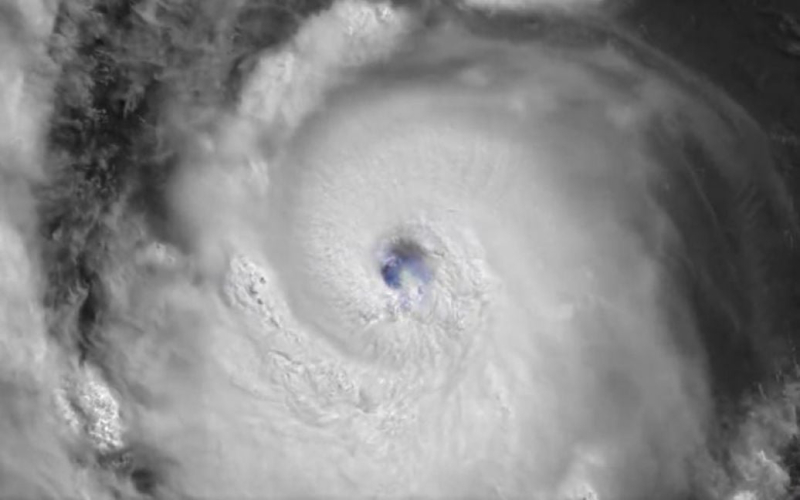
Hurricane Beryl has caused widespread destruction in the Caribbean and is heading towards Jamaica and Mexico.
Hurricane Beryl became the fastest storm in Atlantic history to grow into an intense Category 5 hurricane, which took at least a few lives within a few days at least nine people and caused significant destruction in the Caribbean islands and Venezuela. Now the disaster is moving towards Jamaica. According to meteorologists, the hurricane's wind speed is about 215 km/h.
Mirror writes about this.
Jamaica, Grand Cayman, Little Cayman, Cayman Brac and the entire southern coast of Haiti are preparing to face the destructive elements. Residents were warned of possible evacuation. Despite predictions that Beryl will lose some of its strength along the way and has already been downgraded to category four, forecasters warn it could still cause significant damage when it reaches Jamaica on Wednesday. The storm will reach the Cayman Islands by Thursday and move into Mexico's Yucatan Peninsula by Friday.
Shocking videos of Hurricane Beryl
The American Cooperative Institute for Atmospheric Research (CIRA) has released an eerie video of Hurricane Beryl in the Caribbean Sea, filmed aboard the International Space Station on Monday, July 1st. Numerous flashes of lightning are visible in the center of the hurricane.
A remarkable hi-res view of abundant lightning flashes within Hurricane Beryl's eye wall. pic.twitter.com/1XqCLMRQno
— CIRA (@CIRA_CSU) July 1, 2024
“Hurricane Hunters” also shocked their followers on the social network X by showing a video of the “eyes” of a hurricane, filmed in its very center by the camera of a research aircraft.
A look into the eye ️ of Hurricane Beryl today. Late Monday, Beryl became the earliest storm to develop into a Category 5 hurricane in the Atlantic, though it was downgraded Tuesday to Category 4.
For up to date forecasts visit https://t.co/96ZlCzpVcZ#hurricaneberyl pic.twitter.com/Dd81YzOuuM
— Hurricane Hunters (@53rdWRS) July 2, 2024
NASA uses such images and observations to study hurricanes. This unique footage helps scientists understand the impact of climate change on hurricanes and how people can prepare for tropical cyclones in a warming world.
Why hurricanes occur
Phys.org explained that hurricanes are tropical cyclones that form over the Atlantic Ocean or the eastern Pacific Ocean. Their strength is fueled by the warm, moist air over the ocean. It rises up from the water, creating an area of lower air pressure. Air from surrounding areas of higher pressure is pushed into an area of lower pressure. This “new” air then becomes warm and moist and rises as well.
As warm air continues to rise, surrounding air masses swirl to take its place. At the top, the air cools, and the water in it condenses and forms clouds. The entire cloud and wind system rotates and grows, fueled by ocean heat and water evaporating from the surface.
Aftermath of Hurricane Beryl
At least seven people have died in the Caribbean islands. One person was crushed by a huge tree that fell in Grenada during a storm.
Kerryn James, Grenada's Minister of Climate Resilience, Environment and Renewable Energy, said many buildings and communications were destroyed, leading to food and drinking water shortages.
Prime Minister of Grenada Deacon Mitchell called the situation in the state “grim” and spoke about the consequences of the disaster.
“There is no electricity and houses and buildings on the island are almost completely destroyed. Roads are impassable and in many cases completely closed. The possibility that there may be more casualties remains a grim reality as movement remains strictly limited,” Mitchell warned.
On the islands of Carriacou and Petit Martinique, 98% of buildings were damaged or destroyed. Hurricane Beryl also caused “unimaginable” destruction in St. Vincent and the Grenadines.
HURRICANE BERYL ON A PATH OF MASS DESTRUCTION ACROSS CARIBBEAN – CAT 4/5
98% of buildings on Carriacou and Petite Martinique were damaged or destroyed.
Hurricane Beryl is barreling towards Jamaica as a Category 4 storm after causing “unimaginable” damage in Grenada, St.… https://t.co/Q9evPFZeko pic.twitter.com/71vDpXu3uz
— Mario Nawfal (@MarioNawfal) July 3, 2024
Two more bodies were discovered in northern Venezuela, where five people are currently missing. Eight thousand houses were also destroyed.
Recall that powerful bad weather hit Ukraine in mid-June.
Related topics:
More news

